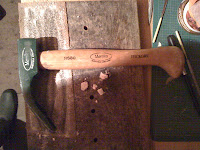I've always had a fascination with knives. Not so much as weapons (though I'd be a liar to say it's not something to do with the latent danger within a sharp knife) but much more so as tools. It's probably in large part due to the fact that when as a youngster I bought a knife, usually a folding knife while on holiday (I've always wondered why there are so many knives on sale in British sea-side towns?) my Mum would always sneak it away and hide it - she has a fear of knives, in fact of anything dangerous, like wardrobes (only joking Mum).
Anyway, when a couple of years ago I discovered I could make my own knives, well, I was in my element. I've made a few over the years, though I don't get a lot of time for knife making and it's fairly time consuming. My brother Ju and I annealed a bunch of old files a couple of weeks ago which he'd found dumped at the roadside, so I've had plenty of steel at hand. Here are a few that I've made recently.


This is a friction folder (brass pins, oak handle, ebony liner - but you can't actually see that on the photos) that I made for my brother Ju. He happened to comment that we both seem to make knives that end up being sold or given to someone else and that we should make one for each other. He made me a rather nice whittling knife so I made this one for him.
This is a bit of a general purpose utility knife - I know it looks like a filleting knife but the blade is thicker than it actually looks and has very little spring. Unpolished steel blade, copper bolsters (recycled from a PC heat sink), black horn and some American walnut given by a colleague whose friend makes kitchen cabinets.

This is a tiny knife I made for a friend of my son's. His family had an apple tree in their back garden which his dad cut down and burned in their log burner. he salvaged a small piece of branch we he then asked me if i could make something from it as a keepsake. this was going to be a neck knife but it turned out a little bigger.

Apologies for the orientation of this picture - I haven't worked out how to turn pictures yet (Blogger seems to have a mind of its own) - but this last one is a camping knife I made for my son's eighteenth. I'd been promising to make him a knife for years, but never got round to it. Again, recycled copper bolsters, horn and wallnut spacers and stacked leather in the middle.
















































